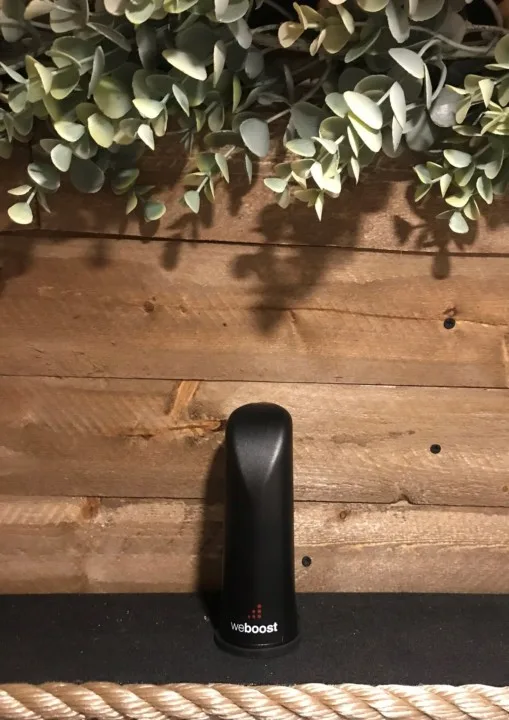
When we first started looking into purchasing the Weboost Drive 4G-X RV, I searched online for in-depth reviews. The reviews I found were super mixed between: “it works great” and “it’s a piece of crap”. So, I decided to write an honest review on the WeBoost. We have now owned ours for 3+ years.
We are travel bloggers, as you probably noticed, because you are on our website right now! The Internet is something we depend heavily on to make an income and to keep this blog up and running. Therefore, we wanted a device that would boost our cellular signal when we are in places where the signal is weak.
This post is not sponsored, we bought the Weboost at full price
This post may contain affiliate links. Disclosure policy.
My Opinion of The Weboost:
Overall, I think that the WeBoost is a quality product, but the price is a bit steep. I had super high expectations that this booster would work in places you wouldn’t expect. But it mainly works in places you already have decent service.
I think I envisioned a magic antenna that could pick up signal from anywhere and make internet magically appear. But after using it and fully understanding how a WeBoost actually works, I realized I had the wrong expectations.
Using the we-boost is almost a game of luck. Sometimes it works in places you wouldn’t expect (aka the middle of nowhere), but often times it only works when you are near a city or town where it can boost off their cell towers.
If you often travel near cities and towns, then this is a good purchase for you. If you exclusively get off grid in super remote areas, then chances are this device will often not work for you.
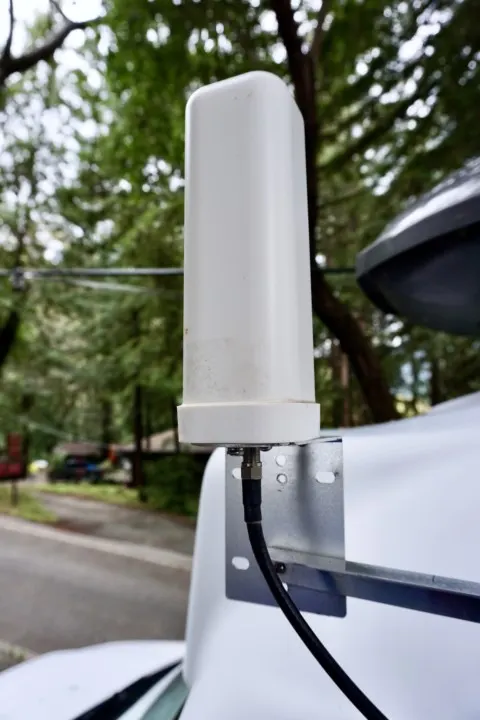
How Does a Weboost Work:
The WeBoost is a cell signal extender. Which means that it simply picks up any cellular signal in the air and amplifies it inside your vehicle. It cannot create signal out of thin air.
The WeBoost Drive 4G-X RV has two antenna’s and a “booster” device in the middle. One antenna is placed outside the van/RV and the other is placed inside, at least 10 feet away from the outside antenna. (Which can be tough in smaller rigs.) If the antennas are placed too close to each other you will create oscillation (interference between the antennas).
The outside antenna picks up cell signal for any nearby towers, and sends that signal to the booster inside. The booster then can amplify that signal (up to 32X) and rebroadcasts it through the inside antenna. Then functionally, you can use the signal with you phone or other devices like you would any other cell signal.
So for example, we upgraded our iPhones to a Verizon Unlimited data plan. Our plan now has high speed internet up to 50GB for cellular data and 50GB of hotspot data. The hotspot data is what allows us to turn our phones into a Wifi hotspot and connect our computers to the internet.
Therefore, if you venture far from cities and towns, then chances are cell towers are far and few between. Making it more of a challenge for the antenna to find signal. And cell signal is especially bad in mountains because they physically obstruct the signal.
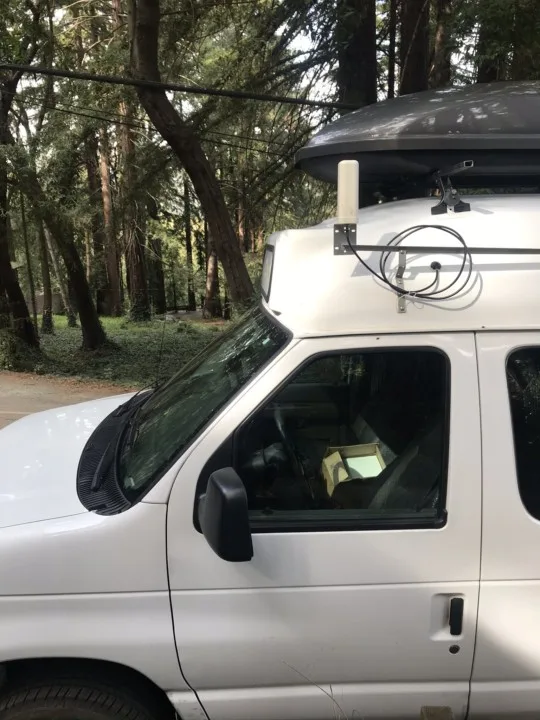
How Well Does a Weboost Actually Boost Your Signal:
The WeBoost claims to boost up to 32x, so it’s directly dependent on the available signal. Because 32 times zero is still zero, so it’s not magic.
The WeBoost boosts the signal very well when there is some signal to work with. So when you have just a few bars or when you have “slow internet” such as 3G, and you can still use your phone and hotspot, but things are just running at a snail’s pace. These scenarios are great to have the WeBoost, because it drastically changes our capabilities. We have gone barely being able to load a single web page to working efficiently on blog posts and research.
When your phone has “no service” or says 1x but nothing loads, then chances are that the booster won’t really give you “passable” signal. There are rare cases where you might get a website to load, but you can’t get much further than that. So don’t depend on having usable signal if your phone doesn’t have any signal either.

One annoying thing we noticed the booster does is says it has full bars but it clearly doesn’t because you can’t get anything to load. This is usually at times when you have either no service or 1x. So we have learned to not even bother at times when we don’t have any signal on our phones.
There are still other great ways to get an internet connection on the road. Or there are also wifi boosters that can boost a wifi signal to be stronger in your camper van.
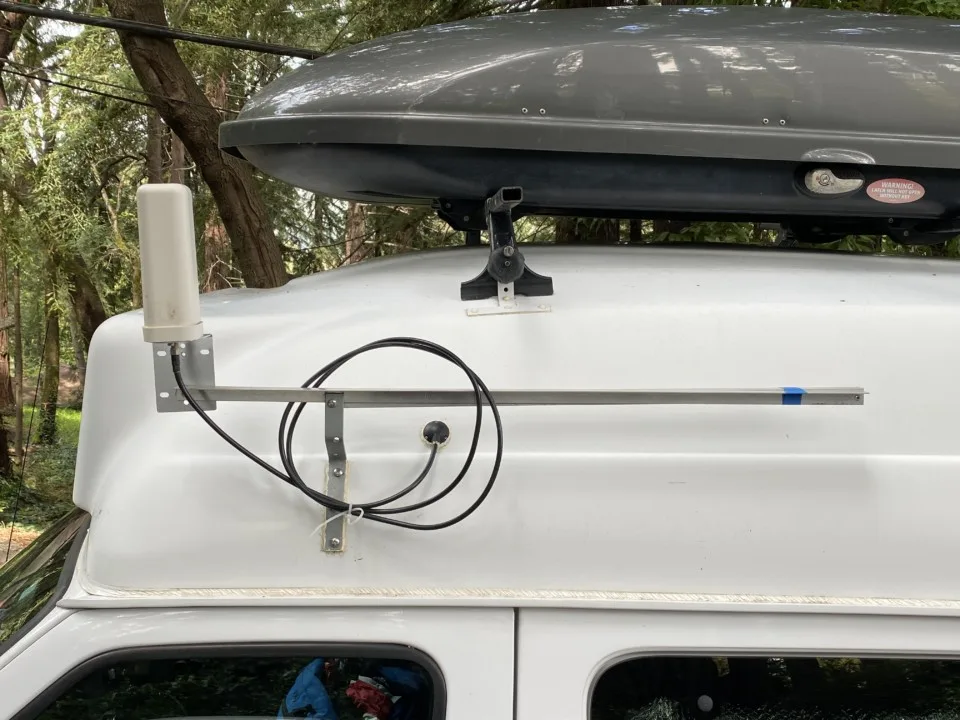
Installation of a Weboost:
To install the WeBoost you need to mount the outside antenna somewhere on the outside of your vehicle. The best place to mount it is up high, ideally higher than anything else on your roof. That way incoming signal cannot be obstructed. And since the outside antenna and inside antenna need to be at least 10 feet apart, most people will mount the antenna at the very front or back of their roof.
We considered getting a telescoping pole so that we could raise the antenna when we are stationary. (WeBoost recommends this as a good strategy for getting better signal.) But instead, Jake rigged up a DIY extendable arm. But admittedly, it’s a pain to use, so we never extend it.
Our campervan is barely long enough to achieve this 10ft distance. We mounted the outside antenna at the front of our vehicle’s roof, because we primarily wanted to use the inside antenna in the back of our van, where the bed and desk are.
The WeBoost comes with a couple “U” shaped bolts for attaching the outside antenna to the top of an RV ladder. We don’t have a ladder or post to attach it to, so we decided to make our mounting bracket out of an “L” brace.
Then the wire needs to be fed inside the vehicle. We drilled a hole in our fiberglass roof and used the supplied flange to finish off the opening.
The Booster just needs to be mounted somewhere inside the vehicle and supplied power. We mounted it on the side of our closet where it’s out of the way. It can be powered via a normal AC plug, or 12v power (both methods supplied).
And then the interior antenna can be placed anywhere inside the vehicle that’s at least 10 feet from the outside antenna. For us, the opposite rear corner is the only place that fits that criteria. So we just place it on the shelf above our bed.
Price:
(Update: Weboost has since changed the design and updated a few features)
The Weboost Drive 4G-X RV costs: $449.99
In my opinion, the WeBoost is a bit expensive for the job it actually does. I think it’d be worth $500 if it had a consistent internet connection wherever you traveled. But the fact that it doesn’t work in the areas you want it most (such as deep in the backcountry) it’s priced too high.
I’d value it around $350. But they do make some less expensive products for passenger vehicles that are priced cheaper. But the trade-off is that the interior antenna has a much smaller range, so they are not good for bigger spaces (like a campervan or RV).
Update: Starlink has since come out, which could be a better option for people who travel off-grid. But do note there will be a monthly payment. Weboost is a one-time purchase product to hopefully last you forever.
Who Is The WeBoost Good For?
I’d only suggest the WeBoost to people who are often near places that have “decent cell signal”. Or for people who work remotely or rely heavily on the internet.
One argument you can make, is if you are already near towns and cities often, then you might already have good enough service to use your phone and hotspot without a booster. Or you can find free places to work such as a library, McDonalds parking lot or public park. But, unfortunately those businesses close or you need to go park for the night and you will no longer have access to those internet sources. And this is where having a booster is useful.
For people who work remotely, you have to ask yourself the question, will you make up the money you are spending on this device. For example, if you are a travel blogger like us, will it allow us to continue to use the internet when we are parked for the night and get some work done? The alternative, is maybe we don’t have good enough service and just play a game or read a book.
Or will you make the money up from not having to spend money for internet? For example, if you go to a coffee shop every time you need internet and spend $5-15 on coffee/food, then it might be worth it to purchase a WeBoost. The money you save on making your own food and using the internet inside your RV or Van could make up the price of the WeBoost over time.

If you are just looking to scroll through social media and just boost your signal for non-work related activities, then I’d think twice before buying this. If you just need that extra little boost, then the WeBoost is a great option.
Our Final Thoughts:
Now that we own a WeBoost, we are happy we have it. We feel we have gotten our moneys worth from the amount of times we used it when service was spotty. But, if we would’ve known how poor it would work in backcountry areas, then we might have reconsidered a different option. We had expectations that it would be serviceable in places where we had 1x, but unfortunately that is not the case.
The WeBoost is a product that helps make you feel more in touch with the world, and makes living in a van or RV feel more like home. Rather than when you’re camping and trying to shut out the outside world for the weekend.
If you travel to places where service is decent and you just need that extra boost to get “high speed internet” then a weboost is worth it! But if you exclusively go off-grid deep in the backcountry, than I’d think twice before making this purchase! We hope this helps you make your decision!
We have since upgraded to the Starlink Roam which provides uninterrupted internet at just about any campsite. But we still do use our Weboost cell-signal Booster when we are in public areas and we don’t want to set up the Stalink Dish.
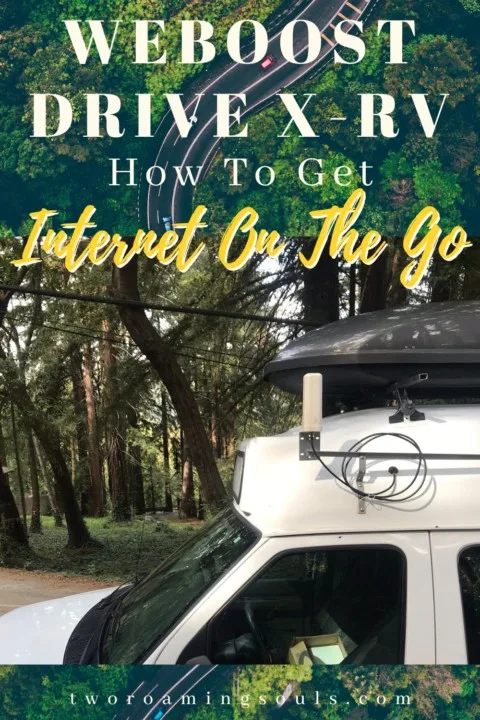
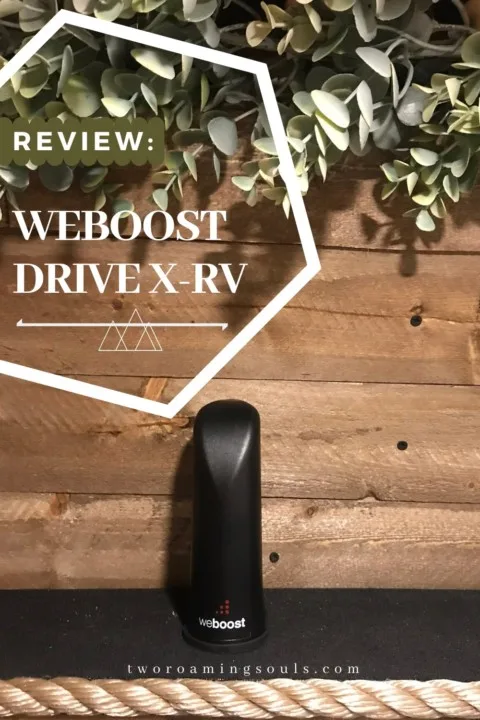

How Much Did Our DIY Camper Van Conversion Cost - tworoamingsouls
Friday 5th of May 2023
[…] also added a WeBoost (review: Should you buy a WeBoost Cell Signal Booster?) so we could boost our signal to use our mobile hot spots in areas that service isn’t strong […]
Reality Of 'Heading South for the Winter' In Vanlife | Snowbirds Lifestyle - tworoamingsouls
Friday 7th of April 2023
[…] that you may be camping won’t have good cell signal. We highly recommend getting a cell signal booster if you plan to work this […]
How To Get Vanlife Internet? | Best Devices For Portable Wifi - tworoamingsouls
Thursday 6th of April 2023
[…] Review: Should You Buy A Weboost (Cell-Signal Booster)? […]
Ultimate Gift Guide For Vanlife - tworoamingsouls
Tuesday 4th of April 2023
[…] For more information on the WeBoost, check out our review: Should You Buy A WeBoost (Cell-Signal Booster?) […]
Ultimate Camper Van Hacks To Make Vanlife Easier - tworoamingsouls
Saturday 11th of February 2023
[…] and I use the Weboost Cell-Signal Booster which can boost our cell-signal on our cell phones up to 32 […]